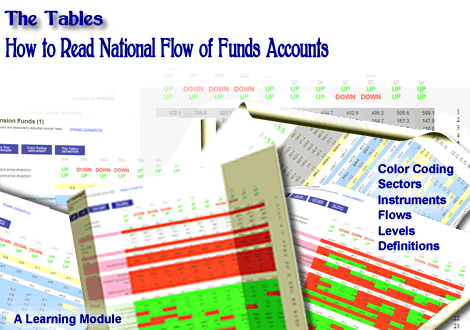Investment Tutorial: How to Read Federal Reserve Flow of Funds Accounts

Investment Tutorials: 
How to Read Federal Reserve Flow of Funds Tables
Capital Flow Analysis is based on national flow of funds accounts.
In the United States, these statistics are compiled and published by the Board of Governors of the Federal Reserve System.

This data (called Release Z.1) is available without charge on the Federal Reserve web site.
The reports are available during the second weeks of March, June, September, and December.
Release Z.1 contains about 125 pages of tables.
Historical tables back to 1945 are also published.
Federal Reserve Release Z.1
Federal Reserve Board Quarterly Release Z.1, 'Flow of Funds Accounts of the United States', contains about 172 statistical tables, many of which are useful for Capital Flow Analysis.
About 80 percent of these tables refer to the flow of funds among various financial instruments and economic sectors.
The remaining tables deal with macro-economic statistics.
The types of flow of funds tables of particular interest to Capital Flow Analysis are sector tables and instrument tables.
Flow of Funds Vocabulary
National flow of funds accounts and Capital Flow Analysis has its own jargon and special terms that you need to understand.
Here is the essential vocabulary:
Flow: The difference (positive or negative) between levels measured at the end of two periods.
Level: The outstanding balance of an asset or liability at the end of a period.
Sector: An economic group as designated in the national flow of fund accounts. Examples of sectors are 'Households and Nonprofit Organizations', 'Mutual Funds', and 'Commercial Banks'.
Instrument: An economic asset or liability as designated in the flow of fund accounts. Examples of instruments are 'Mutual Fund Shares','Corporate Equities', and 'Corporate and Foreign Bonds'.
Player: Same as 'Sector'. A term used in Capital Flow Analysis.
Securities: Same as 'Instrument'. A term used in Capital Flow Analysis.
NIPA: National Income and Product Accounts. Macro-economic statistics included with the flow of fund tables.
Release Z.1: Quarterly statistics on the National Flow of Funds Accounts of the United States published by the Federal Reserve Bank.
Before proceeding, check your progress:
Self-Test
Capital Flow Analysis is based on:
|
|
Capital Flow Analysis focuses on:
|
|
NIPA stand for:
|